|
An
extensive article introducing non-modelers to aircraft modeling appeared in the Annual Edition of the 1962 American
Modeler magazine. 15 pages were devoted to describing just about every aspect of model building and flying - free
flight gas and rubber; control line stunt, combat, scale, and speed; helicopters and ornithopters; indoor gliders,
stick and tissue, and microfilm; even some early radio control. In order to keep page length here reasonable
(because of all the images), the article is broken into a few pages. Pages: |
10 & 11 |
12|
13 |
14 |
15 |16
| 17 |
18 |
19 |
20 |
21 |
22 |23
| 24 | For Non-Modelers: All About
Air Modeling
20 Easy Ways to Go Crazy! <previous> <next>
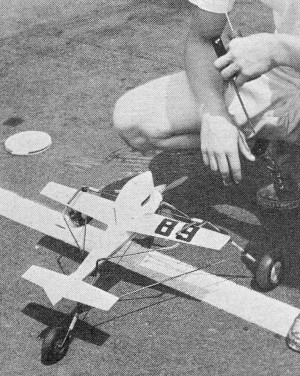
Control line speed model rests in launching dolly. As plane becomes air-borne after take-off run around the flight
circle, dolly drops away.
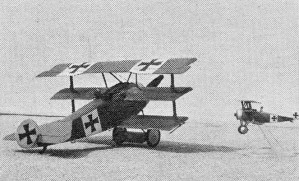
Plastic scale models can be purchased in a variety of sizes and scales. Two Fokker triplanes above are American
molded 10-1/4" span and English Airfix 3-3/4" span, 1/72 actual size.
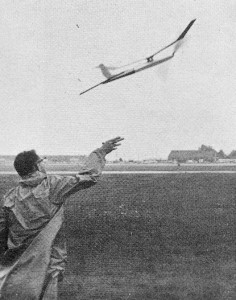
Rubber powered Wakefield model flown (be-low) by former National champion, Henry Struck of Conn.
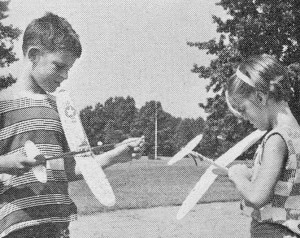
Lots of youngsters first fly with catapult folding-wing glider (AJ Interceptor) and rubber powered, prop driven
AJ Hornet.
CLIPPER CARGO FREE FLIGHT (Discontinued) - Pan Am also sponsored contest events for conventional
gas engine powered models in addition to the PAA-Load event for rocket power already described. Two events were flown,
PAA-Load with 1 oz. dummy pilot and Clipper Cargo with 1 oz. pilot plus 1 oz. dummy cargo "box." The popular .020
cu. in. engine was maximum size allowed and maximum model dimensions for PAA-Load were 36" and 48" for Clipper Cargo.
Most PAA-Load models were conventional free flight tractor design having light built-up tissue covered structures.
Space had to be provided for dummy pilot or cargo which was a specified size. "Pilot" visibility and enclosure were
also required. Much experiment with pod and boom and semi-scale amphibian designs added originality to this competition.
The PAA-Load event scoring was based on endurance and the Clipper Cargo event scoring was based on maximum gross weight
lifted. This was the alt-up weight of model, fuel, payload and ballast, if any. A Clipper Cargo record was established
when gross weight of 51 oz. was flown. That's a bit over THREE pounds and this behind a Pee-Wee .020 engine. Minimum
flight duration could not exceed 40 sec. and payload had to be carried and landed safely to gain credit for an official
flight. GAS MODELS FREE FLIGHT - Far and away the most popular model' competition event,
gas powered free flight has been the "main event" since the early 30's. Its popularity is strongly challenged now
by control line flying because of -the wide open flying spaces required for the modern powerful high performance designs.
Where in former years six foot monsters staggered into the air for short hops behind straining "60" engines; by contrast
today's 1/2A engine yank three foot models straight up hundreds of feet to glide for many minutes, even hours. Through
the years as free flight model performance got better and better, shorter and shorter engine run limitations had to
be imposed to prevent fly-aways. Today, engine runs are limited to 20 sec. for R.O.G. takeoff and 15 sec. for hand
launching. Flight timing is limited to 5 minutes in competition making dethermalizers necessary to bring model down.
Out-of-eight flights within the 5 minute limit often occur. Free flight contest gas models are divided into
classes according to engine size: Class 1/2A-.OOO to .050 cu. in. displacement. Class A-.051 to .200 cu. in. and Class
B.201 to .650 cu. in. There is an additional class flown in International competition, FAI Power, with engine size
limit of .1525 cu. in. and other limitations, which is gain' ing steadily in popularity here. Free flight
models follow the typical design and structure pattern of the towliners and rubber jobs already described. Construction
is somewhat heavier to withstand engine vibration and higher climb speeds. Wings and tails are built-up with tissue
and fabric covering. Fuselages usually employ sheet balsa construction. Timers are used to cut off fuel supply to
"glow" engines within the engine run time limits. Dethermalizers such as the pop-up stabilizer described for towline
gliders are a "must" to bring model down out of thermals. Few limitations are placed on free flight designs.
R.O.G. models must be able to rest unassisted in take-off position. Wheels and skids though not required are usually
employed. The modern free-flight capable of VTO starts (vertical-take-off) have tails parts fitted with appropriate
stands or skids to perm it this. Models are also flown R.O.W. as seaplanes. No special designs are used, the
typical R.O.G. model being equipped with detachable floats and pontoons. Same engine classes are used and engine run
is 20 sec. in competition.
Free flight models range in size from about 3 foot span for 1/2A's to 6 foot and over for the big 60's.
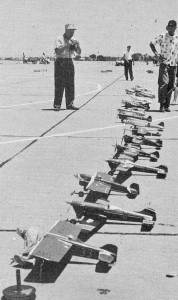
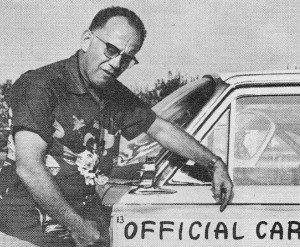
Line up of team racers at National In addition
to 1600 contestants and uncounted
competition draws nation's best
models, the 1961 USA Nationals required
flyers and planes. These are finalists
hundreds of officials like chap above.
before con-cluding "heats."
<previous> <next>
Posted December 25, 2010
|


